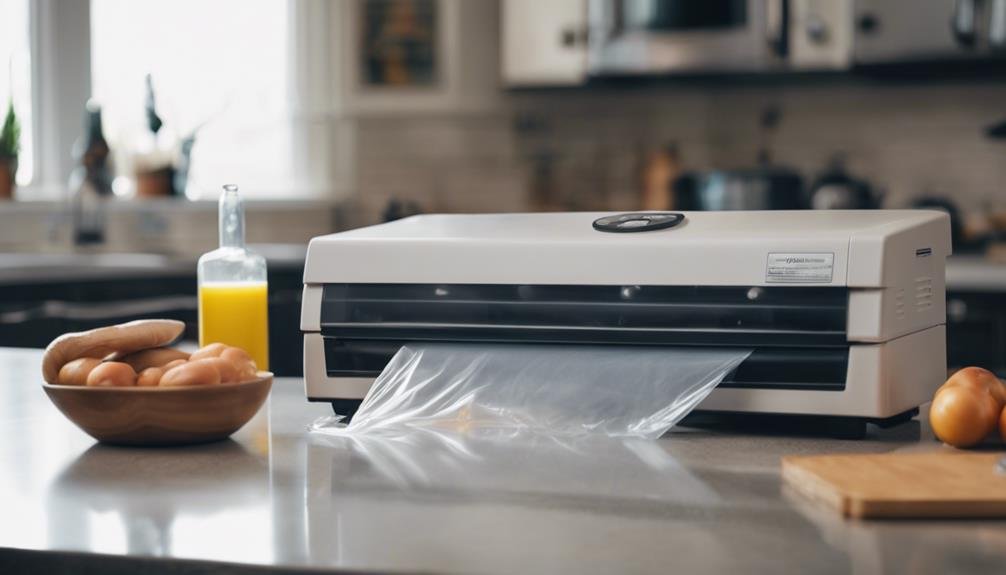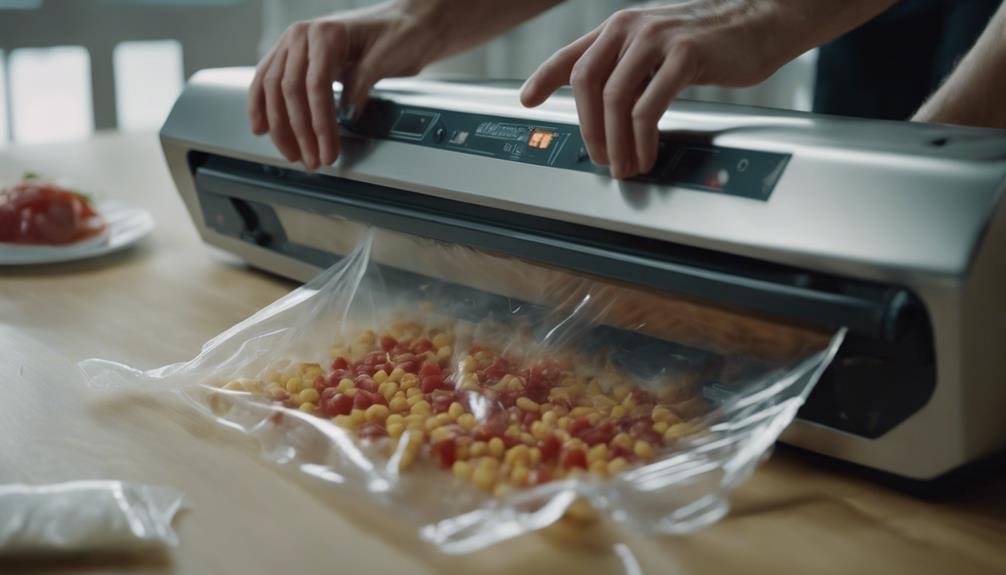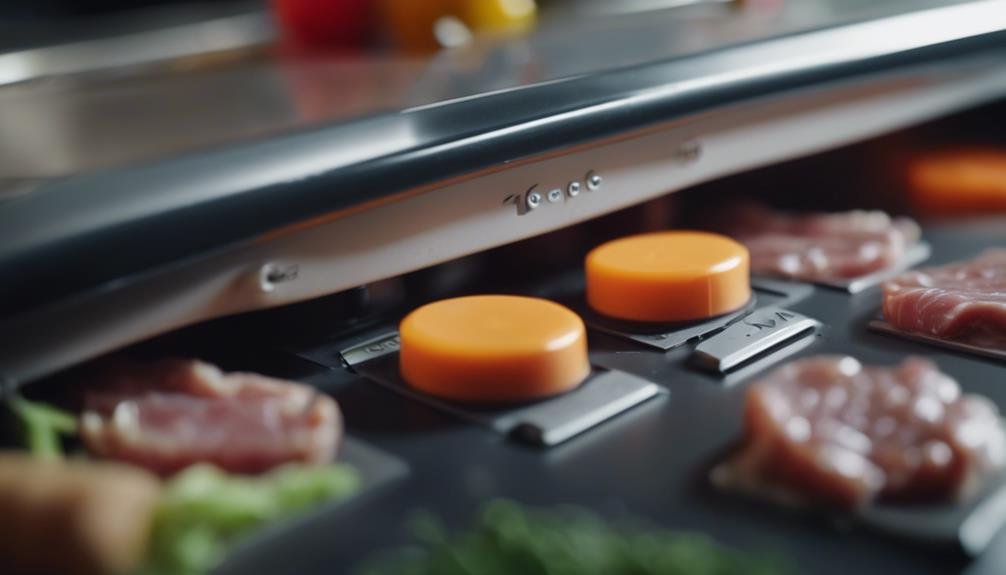To troubleshoot error codes on a vacuum sealing machine, start by identifying the specific code displayed. If you encounter Error Code 13 related to voltage issues, check the input voltage and the motherboard. For Error Code E05, ensure to clean and lubricate the lower mold motor tracks. Address concerns with the safety door for Error Code 7 by examining emergency buttons and micro switches. Inspect wire connections to resolve Error Code 22, which is often linked to power-on switch problems. If you come across Error Code 10, consider the possibility of replacing the motherboard. Proper placement and cleanliness of the bags are crucial to prevent errors. If problems persist, it may be helpful to reach out to customer support for further assistance.
Common Error Codes
Understanding common error codes on your vacuum sealing machine can save you time and prevent unnecessary frustration. When your vacuum sealer displays Error Code 13, it's indicating a voltage error. First, make sure that your machine's input voltage matches the specifications. If that doesn't resolve the issue, inspect the motherboard for any signs of damage or malfunction.
Encountering an E05 error code? This usually means there's a problem with the lower mold motor. You'll want to clean and lubricate the tracks thoroughly. For a more detailed guide, a helpful video can walk you through the process.
Error 7 is related to the safety door. To fix this, check the emergency buttons, safety doors, and micro switches to ensure they're functioning correctly. If any component is faulty, replacing it should clear the error.
If you see Error 22, it's tied to the power-on switch. Examine all wire connections for any loose or burnt wires. A detailed video can also assist you in diagnosing and fixing this issue.
Lastly, Error 10 points to a problem with the IC board and control system. This often requires replacing the motherboard, and a step-by-step video can guide you through this replacement process.
Bag Placement Issues
Proper bag placement is essential to make sure your vacuum sealer operates effectively and achieves a strong seal. One common issue with sealer machines stems from improper bag positioning. The colored line inside the sealing chamber is your guide—always align the edge of the bag with this line. If the bag isn't correctly placed, the machine can't create an adequate vacuum, leading to weak seals or no seal at all.
Another common bag placement issue involves using bags that are too large. Excessive bag size can obstruct the suction process, preventing the machine from removing all the air. To avoid this, make sure the bag size doesn't extend past the designated line in the chamber.
Additionally, check for dirt buildup between the lid and the machine, as this can interfere with suction and sealing. A clean sealing surface ensures the machine works at its best.
Sealing Bags or Rolls

When sealing bags or rolls, inspect them for any pinpoint holes that could compromise the vacuum process. Even the tiniest holes can let air seep in, affecting the efficiency of your vacuum sealer machine. It's important to address these holes promptly to maintain a proper vacuum seal. Before you start sealing food items, verify that there are no leaks in the bags or rolls. This small step can save you a lot of hassle and guarantee that your food stays fresh for longer.
If you do find any holes, don't ignore them. Patch or replace the damaged bags or rolls to prevent air leakage. Using compromised materials will lead to poor sealing results and defeat the purpose of using a vacuum sealer machine. By keeping an eye out for these issues, you'll enhance the performance of your machine and make sure that your stored items are well-protected.
Moisture and Oil Problems
Excess moisture and oil in your food items can greatly hinder the vacuum sealing process, leading to subpar results. These elements can cause the seal to be incomplete, resulting in air leaks and potential spoilage. To avoid such issues, always blot excess moisture from your food with paper towels before sealing. This simple step can prevent many common errors in the sealing process.
Furthermore, it's essential to confirm your machine is level and all plugs are securely in place. A stable machine can handle the sealing process more efficiently, reducing the risk of food particles or liquids interfering with the seal. If you notice any residual oil or moisture in the sealing area, clean it promptly to maintain peak performance.
Leaving a 1-inch gap between the food and the edges of the bag is another effective way to achieve a strong seal. This space allows the machine to create a proper vacuum without being obstructed by food particles or liquids. By taking these precautions, you'll minimize errors and enhance the longevity of your vacuum-sealed items. Remember, a little preparation goes a long way in ensuring the quality and safety of your stored food.
Overfilling Bags

Taking care to avoid excess moisture and oil is important, but equally critical is making sure you don't overfill your bags. When you overfill, you compromise the sealing process, leading to potential errors and a less secure seal. To avoid this, always leave at least 1 inch of free space between the food and the bag edges. This space is essential for allowing the bag sides to make proper contact and form a strong seal.
Overfilling can lead to several issues:
- Liquid Runoff: Excess liquids can escape and interfere with the sealing process.
- Blockages: Overfilled bags can cause blockages, preventing the machine from functioning correctly.
- Compromised Seals: Without adequate space, the seal might not be secure, leading to leaks.
- Spills: Properly filled bags minimize spills and ensure a tidy process.
Inspecting for Holes
Carefully check your sealing bags and plastic rolls for any tiny holes that might disrupt the vacuum seal. Even the smallest punctures can allow air to seep in, which compromises the sealing process and affects food preservation. To maintain peak vacuum seal efficiency, you must inspect sealing bags and plastic rolls thoroughly before use.
Here's a quick guide to help you identify and address any potential issues:
| Step | Action |
|---|---|
| 1 | Lay out the bag or roll flat |
| 2 | Visually scan for any visible holes |
| 3 | Feel for any irregularities or weak spots |
| 4 | Test by filling with water if unsure |
Finding a hole means you need to patch or replace the bag or roll immediately. Don't risk using compromised materials, as it could lead to spoilage. By ensuring there are no leaks before sealing food items, you can effectively prevent spoilage and maintain the freshness of your stored food.
Adjusting Settings

After inspecting for holes, you'll need to adjust the settings on your vacuum sealing machine to guarantee optimal performance. Proper temperature and pressure settings are essential for achieving airtight seals. Incorrect settings can lead to issues like incomplete seals or overheating. To get the best results, here are some troubleshooting tips to keep in mind:
- Check the Temperature: Make sure the sealing temperature is appropriate for the type of bag you're using. Too high, and it might melt the bag; too low, and it won't seal properly.
- Adjust the Pressure: Confirm that the vacuum pressure is set correctly. Insufficient pressure can result in air pockets, while excessive pressure might damage delicate items.
- Seal Time: Adjust the sealing time according to the thickness of the bag. Thicker bags require more time to seal effectively.
- Consult the User Manual: Always refer to the user manual for specific instructions on adjusting settings. Each machine can have unique requirements.
Maintaining the Machine
To maintain your vacuum sealing machine running smoothly, regular maintenance is crucial. Start with daily tasks like wiping the machine surface, checking for visible damage, and testing the power switch. A clean surface prevents dust buildup, and a functional power switch guarantees uninterrupted operation.
For weekly maintenance, focus on thoroughly cleaning the sealing jaw and all moving parts, especially the conveyor belt. The sealing jaw's heating element is crucial for proper sealing, so make sure it's free from debris. Lubricate the moving parts to reduce friction and wear.
Monthly, conduct a thorough inspection. Check all components, replace damaged parts, and tighten any loose screws. Pay special attention to the heating element and the fructose dispenser if your machine includes one. The heating element should be free of residue to maintain consistent heat distribution, while the fructose dispenser must be clean to prevent clogging.
Keeping detailed records of all maintenance tasks helps track the machine's upkeep. This ensures top performance and prevents unexpected breakdowns. By following these guidelines, you'll minimize error codes and extend the lifespan of your vacuum sealing machine.
When to Call Support

Encountering error codes like E05, E07, or E19 on your vacuum sealer machine is a clear signal to call support. When basic troubleshooting steps don't resolve these machine errors, it's best to seek professional advice to avoid further complications. Here are some specific instances when reaching out to customer support is important:
- Persistent Errors: If error codes like E01 or E04 keep appearing despite your efforts to fix them, it's time to get expert help. These could indicate underlying issues needing professional diagnosis.
- Complex Error Codes: Codes such as E05, E07, or E19 often require specialized knowledge to resolve. Customer support can guide you through the necessary steps or arrange for repairs.
- Unusual Behavior: If your vacuum sealer behaves erratically or shows multiple error codes, contacting support ensures you get accurate troubleshooting steps.
- Preventative Measures: Sometimes, calling support can help prevent minor issues from becoming major problems, saving you time and money in the long run.
Don't hesitate to reach out for professional advice. Accurate troubleshooting from customer support can quickly address vacuum sealer error codes and keep your machine running smoothly.
Conclusion
Mastering your vacuum sealing machine is like tuning a musical instrument. Each error code is a note that guides you towards harmony. By understanding common issues like bag placement, moisture problems, and overfilling, you're adjusting each string for perfect sound. Regular maintenance and knowing when to call support guarantee your machine performs flawlessly. Keep fine-tuning, and you'll hit the right notes every time, preserving your food and peace of mind.
